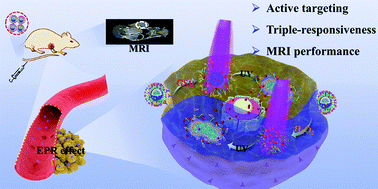Triple-responsive targeted hybrid liposomes with high MRI performance for tumor diagnosis and therapy†
Abstract
Targeted multi-responsive drug delivery systems with magnetic resonance imaging (MRI) capacity were anticipated as a promising tool for tumor therapy and diagnosis. Herein, we successfully synthesized anisamide-modified and non-modified UV/GSH-responsive molecules (10,10-NB-S-S-P-AA and 10,10-NB-S-S-P-OMe), and celecoxib-modified and non-modified UV/H2O2-responsive molecules (10,10-NB-OA-P-CE and 10,10-NB-OA-P-OMe). The targeted MRI-tracing UV/GSH/H2O2 triple-responsive hybrid liposomes (GNSOPAC) were fabricated by mixing with contrast agent (12,12-NB-DTPA-Gd), 10,10-NB-S-S-P-AA, and 10,10-NB-OA-P-CE in an optimal ratio of 6 : 1 : 1. GNSOPAC liposomes presented high DEE (>60%), favorable stability, good biocompatibility, and superior MRI performance. By MR imaging and fluorescence distribution in vivo, targeted drug-loaded liposomes (GNSOPACD) exhibited superior targeting activity than non-targeted drug-loaded liposomes (GNSOPMD) in the in vitro and in vivo studies. Compared with doxorubicin hydrochloride (DOX·HCl), the treatment of GNSOPACD + UV achieved a better anticancer effect in the in vitro and in vivo study, which may be related to the combined action of DOX·HCl, the celecoxib moiety and photolysis products. Moreover, GNSOPACD + UV exhibited negligible adverse effects during the in vivo treatment. Hence, anisamide and celecoxib co-modified UV/GSH/H2O2 triple-responsive hybrid liposomes with high MRI performance can act as a potential drug delivery system for tumor theranostics.

- This article is part of the themed collection: 2021 Materials Chemistry Frontiers HOT articles


 Please wait while we load your content...
Please wait while we load your content...